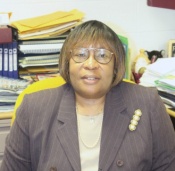 |
 |
|||
|
|
||||
- You are here:
- Home

- Community Development

- Hope Plaza
Hope Plaza Director: Martha Addison

Telephone #: 215-226-7600 ~ Email:
Even after the grand old ballpark was abandoned in 1970, even when it was destroyed by fire in 1971 and its charred shell became a breeding ground for crime and drugs, and even when it was razed in 1976 and would never again wear the noble and ancient dust of ball games, still the fans returned to the site each year to restoke their warm memories of Connie Mack Stadium, nee Shibe Park.
Built in 1909, the ballpark was home to the Philadelphia Athletics (1909-1954), the Phillies (1927; 1948-1970), the Philadelphia Stars of the Negro National League (1933-1952), and local high school teams. Through it all, the park was a uniting force for the neighborhoods and their residents.
Mayor Rendell and other Philadelphians with hearts in the right places put a seven-foot marker in the right place: 21st Street and Lehigh Avenue, site of Connie Mack Stadium. It belongs there for reasons far beyond historical correctness.
Once known as North Penn, or Swampoodle, depending on whom you talk to, the neighborhood around the old ballpark was once a thriving working-class community. It was parceled into little ethnic pockets: Irish to the east and west, Italians to the north, Jews in nearby Strawberry Mansion. Most residents were employed in the local industries and mills: Midvale Steel, Philco, Exide Batteries, Steel Heddle, the Budd Co., Baldwin Locomotive, TastyKake. Separately, they pursued their dreams.
But they were connected culturally, socially and spiritually by the ballpark at 21st and Lehigh. Nearly every home had its baseball stories. Many ballplayers even lived in rooming houses in the neighborhood. Philadelphia A's owner and manager Connie Mack walked from home to work and back.
In the mid-'50s, changes came. Labor costs began to rise, and some of the industries and mills relocated to the south or the suburbs. Some residents, with more money and more mobility (once they bought an automobile), moved to the suburbs. In 1954, the A's fled to Kansas City. And blacks began to move into the once all-white community. In an era of segregation, conflict followed.
``Riots came in August of 1964,'' writes Bruce Kuklick, author of To Every Thing a Season, a must-read on the old stadium and its neighborhood. ``Black anger was now at the doorsteps of the whites, and a white exodus became dramatic overnight.''
Indeed. In 1963, the neighborhood was 85 percent white; by 1969, it was 97 percent black. In 1964, 1.4 million fans visited the ballpark; by 1969, only 500,000 would come. A year later, there was no baseball there, and the park and surrounding community began a slide into decay.
After the '64 riots, fear filled the community for a long time. Vandalism, drugs, gang wars, assaults, burglaries, muggings, even murder kept residents behind locked doors.
The Deliverance Evangelistic Church now stands at the site. It is one of the revivalist forces that saved the neighborhood now known as Allegheny West.
Perhaps the most crucial player was TastyKake. Instead of moving out, the sweet snack company decided to stay put and help rebuild the community. It committed time, resources and money to housing rehabilitation, small-business development and jobs. Community action agencies were formed to reduce crime and drug problems.
In 1980, the Rev. Benjamin Smith purchased the site and the vacant lot across the street, where a year later he built a shopping center and christened it Hope Plaza. In 1990, he broke ground for his new church. Two years later he opened its doors.
The historical commemorative is not far from Bo Bo's Lounge. During the ballpark's great years, Bo Bo's was known as Quinn's, a legendary taproom directly behind the Green Monster, as the right field fence was called. As soon as he turned 21 in 1948, Tommy ``Doc'' Begley was a regular at Quinnies. He could tell by the crack of the bat when a ball was coming over the Green Monster, and he'd hop off his bar stool, rush outside and catch it.
Born and reared in the neighborhood, Begley never left. He couldn't. When all his friends moved out, he moved into a second-floor apartment above Bo Bo's. ``I identified with the streets, the buildings, and most of all, with the old ballfield,'' he once told me. ``This would always be home.''
Many days after the stadium was gone, Begley would look out his second-floor window to the empty lot where his beloved ballpark once stood. He would circle the bases with his eyes: first, second, third, home. Babe Ruth. Ted Williams. Willie Mays. ``I can still see them all,'' he would say.
Tommy Begley died in 1991, still living above Bo Bo's.
So the marker at 21st and Lehigh is for him. Maybe most of all.
B.G. Kelley writes about Philadelphia for the Commentary Page.